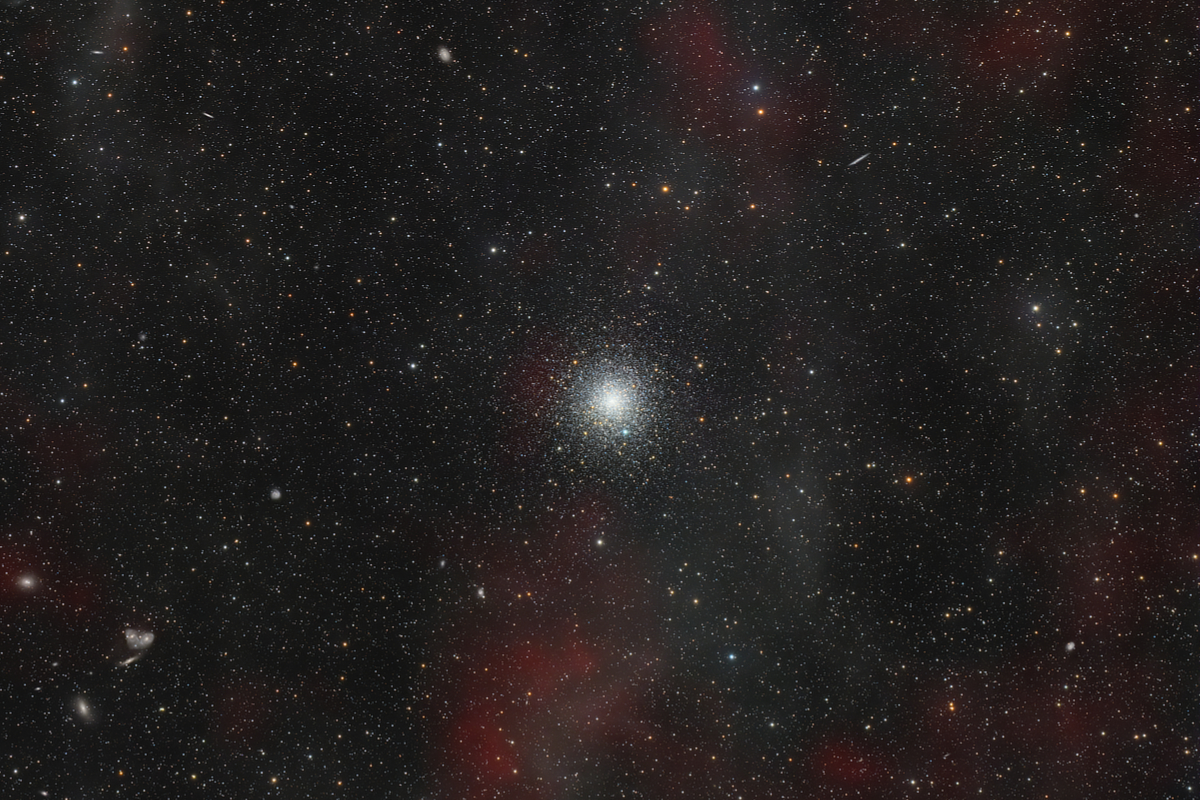
[back]
NGC 6752 (Caldwell 93, Great Peacock Globular) in Pavo
Big, 100%
image version / Große, 100% Bild-Version (9494 x 6296
pixel, 1.464"/pixel)
Anotated Version (9494 x 6296
pixel, 1.464"/pixel)

|
(c) 2025 All astro photo images are copyrighted. They may not be used or reproduced without explicit written permission from the authors. |
|
0.5 degree |
|
About this Image / Über dieses Bild
| Camera: | Moravian C3-PRO-61000 Mono CMOS |
| Image Type, Orientation: | L-RGB-Ha Color Composite, North is at 12:00 |
| Exposure time: | L: 50 x 300 s, RGB: 20/20/20 x 300 s, Ha: 26 x 900 s (15:40h total) |
| Exposure date: | September 9th..October 6th, 2024 |
| Location: | Capella Observatory South at Kiripotib Astro Farm, Namibia |
| Filter: | Astronomik 6nm Ha filter and Astronomik Deep-Sky Filters on Moravian EFW-3L-9-II External Filter Wheel |
| Instrument: | "Callisto", a Takahashi FSQ 106N, 530mm focal length, 106mm aperture, f/5 on modified Losmandy G11 (high res encoders with OnStepX) |
| Photographer: | Rainer Raupach, Josef Pöpsel, Frank Sackenheim |
| Remarks: |
The globular cluster NGC 6752, also known as the "Great
Peacock Globular," is located approximately 13,000 light-years away in the
constellation Pavo. It is the fourth-brightest globular cluster in apparent
magnitude, following Omega Centauri, 47 Tucanae, and Messier 22. With an
angular extent of about 29 arcminutes, it covers nearly the same area of the
sky as the full Moon. Like all globular clusters, it has an age comparable
to that of the Universe. In the foreground, the bluish-appearing binary star
HD 177999, whose primary component is a B-type star, is located at a
distance of nearly 2,000 light-years — significantly closer than the
globular cluster. Of particular interest are numerous background galaxies, most notably the interacting galaxy triplet NGC 6769, NGC 6770, and NGC 6771 (see annotated image version). These three galaxies form the dynamically connected "NGC 6769 Group," which is located approximately 160 million light-years away. This group, in turn, is part of the IC 4845 galaxy group and the larger-scale structure LGG 427. An image of this group, done at nearly ten times the focal length with Ganymed in secondary focus from 2004 can be found here. Within the Milky Way, interstellar matter is visible, scattering the integrated starlight of the galaxy and appearing as nearly color-neutral galactic cirrus. Additionally, faint H-alpha emission features in the form of diffuse filaments are present. |
|
|
|
| Bemerkungen: |
Der Kugelsternhaufen NGC 6752,
auch als „Großer Pfauen-Kugelsternhaufen“ bezeichnet, befindet sich mit
einem Abstand von etwa 13.000 Lichtjahren im Sternbild Pfau. Nach Omega
Centauri, 47 Tucanae und Messier 22 ist er der scheinbar vierthellste
Kugelsternhaufen, und bedeckt mit einer Winkelausdehnung von etwa 29‘ fast
dieselbe Fläche wie der Vollmond. Wie alle Kugelsternhaufen weist er ein
Alter auf, das annähernd dem des Universums entspricht. Der bläulich
erscheinende Doppelstern HD 177999 mit einem B-Stern als Haupt-Komponente
liegt mit knapp 2000 Lichtjahren Entfernung deutlich näher als der
Kugelsternhaufen. |
Back to the Globular Clusters Overview / Zurück zur Kugelsternhaufen-Übersichtsseite